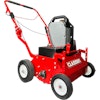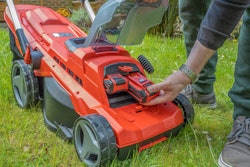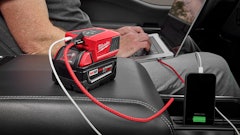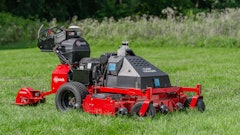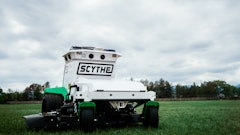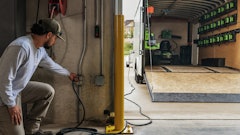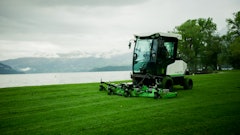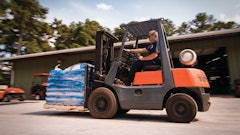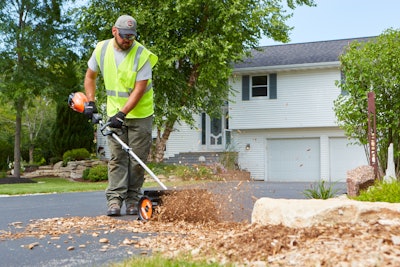
Everywhere you look these days, there are more and more technological revolutions becoming purchase considerations in just about every industry and business sector. The professional landscape market is no exception, and there are probably very few contractors out there that have not had the consideration of switching their fleet to battery power. With the plethora of battery-powered vehicles cruising the streets and autonomous robots cutting swaths through neighborhoods, it seems obvious to make the switch to battery, but what are some factors that would influence this decision?
Local ordinances
Stories seem to be in the news on a weekly basis lately where a local municipality, college campus or homeowner’s association legislates a ban on gas-powered landscape equipment for their locale. In these cases, a landscaper may have no choice but to have a battery-powered option in their truck or trailer as they are forced by local ordinances, but which option? There are many choices available, and several aspects should be considered before adding this technology to your inventory.
Choosing a battery platform
One of the obvious factors in including battery product is which platform to adopt. Competing manufacturers offer different voltages, different battery amperage and maybe even different levels of performance within their own offering. These numbers can often be confusing and a landscape pro can truly determine a real measure of the energy that can be delivered by multiplying the volts and the amps to come up with watt-hours; the higher number, the more energy contained in the battery. And instead of a mix of manufacturers, it makes the most sense to choose brand loyalty. One benefit in choosing a single manufacturer’s platform is the reduction of chargers and the elimination of which batteries are compatible with which equipment and charger. Also, when deciding, look at each manufacturer’s offer including battery compatibility across the full lineup and what products are in the lineup. Will the battery platform selected run all the types of equipment you’d use on a regular basis? Is there a multitool option for running different attachments from one power source? It’s also best to choose a manufacturer with a long-standing reputation as a supplier of professional-grade outdoor power equipment whether it be battery or gas. They understand the rigors of day-in-and-day-out use by a professional and build equipment accordingly.
Run time and performance
Advancements in battery technology are happening every day, and the performance one can expect from a battery unit is increasingly becoming on par with gas. One of the foremost questions on switching to battery is the run time that can be achieved. Industry estimates indicate a standard fuel tank on a gas product, running at wide open throttle, lasts about 45 minutes. Of course, this is dependent on what the application is and how the equipment is operated, and it’s no different with battery equipment. Manufacturers often post run times under specific conditions, and real-world run time is dependent on those same factors as gas. You must consider what are your crews doing daily and how often are they refueling and/or how often would they swap out an exhausted battery. Swapping out batteries is a real situation that leads to another consideration: cost (not only of the units themselves, but also the extra batteries required in the field).
Cost of ownership
Because of the increased performance these days and the cost of building in the latest technology, commercial-grade battery products are about the same cost as commercial-grade gas. The biggest cost savings with battery, however, is in the future when you’re no longer buying fuel and oil to put into an engine. And it’s not just the cost of fuel—which today is historically high—but also consider the time your crew spends at the gas station each morning filling up canisters. Your cost of ownership increases over time on a gas unit with future gas and oil purchases. With either platform, there is still the need to purchase bar and chain oil for chainsaws, so in that regard, battery and gas are even. On the other hand, a huge cost driver on the battery side is the price of keeping multiple batteries in the field for swap out to keep your crews running. Based on average run time data and the number of battery models you’re running, you could need to carry five to 15 batteries (at a pretty hefty price for each one) with your crew per day. As for recharging time, it’s probably best to recharge in your shop overnight so everything is fully charged and ready to go the next day. With these cost factors in mind, it may be better to start small with equipment you use daily—a trimmer and a blower, for example—to get a good feel for a platform before committing to a full line.
Maintenance and service
The operating costs of battery-powered equipment compared to gas-powered goes beyond the fuel and mix oil. There are maintenance and service items to be considered. First off, and related to choosing a platform, is whether the motor in the unit is brushless or brushed. A brushless motor requires far less maintenance than a brushed one. Routine maintenance for common wear items like spark plugs, fuel lines, fuel filters or air filters is nonexistent for battery products. Below is a sample maintenance schedule for gas-powered OPE, and landscape pros can easily determine that maintaining or servicing the first four items is not necessary in a battery-powered item. For either platform, along with checking guide bar nuts, there is still maintenance required to keep a saw chain sharp and to clean sawdust, oil, etc. from the bar and sprocket cover to maintain a smooth-running saw.
Environmental benefits and customer preference
As with the local ordinance legislations described above, landscapers may have no choice but to use battery-operated equipment if their customer(s) prefer that technology be used. Everyone has heard of the benefits of battery product including reduced noise and zero emissions. There are quite a few adopters in agreement with these sentiments or so many battery-powered items would not exist. In many communities, a large portion of residents may feel this way, and this could be an entry point for adding new customers just by having battery product, along with gas-powered for other customers, on your truck or in your trailer.
In the end, when considering the switch to battery, you should factor in the topics above and weigh the risks and opportunities and what makes the most sense for your business, your territory, and your future business plans.


